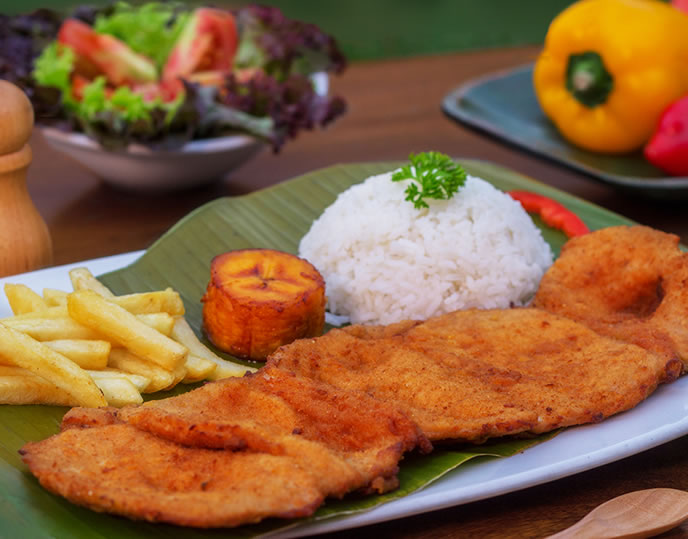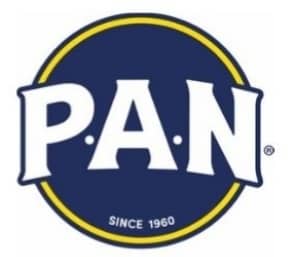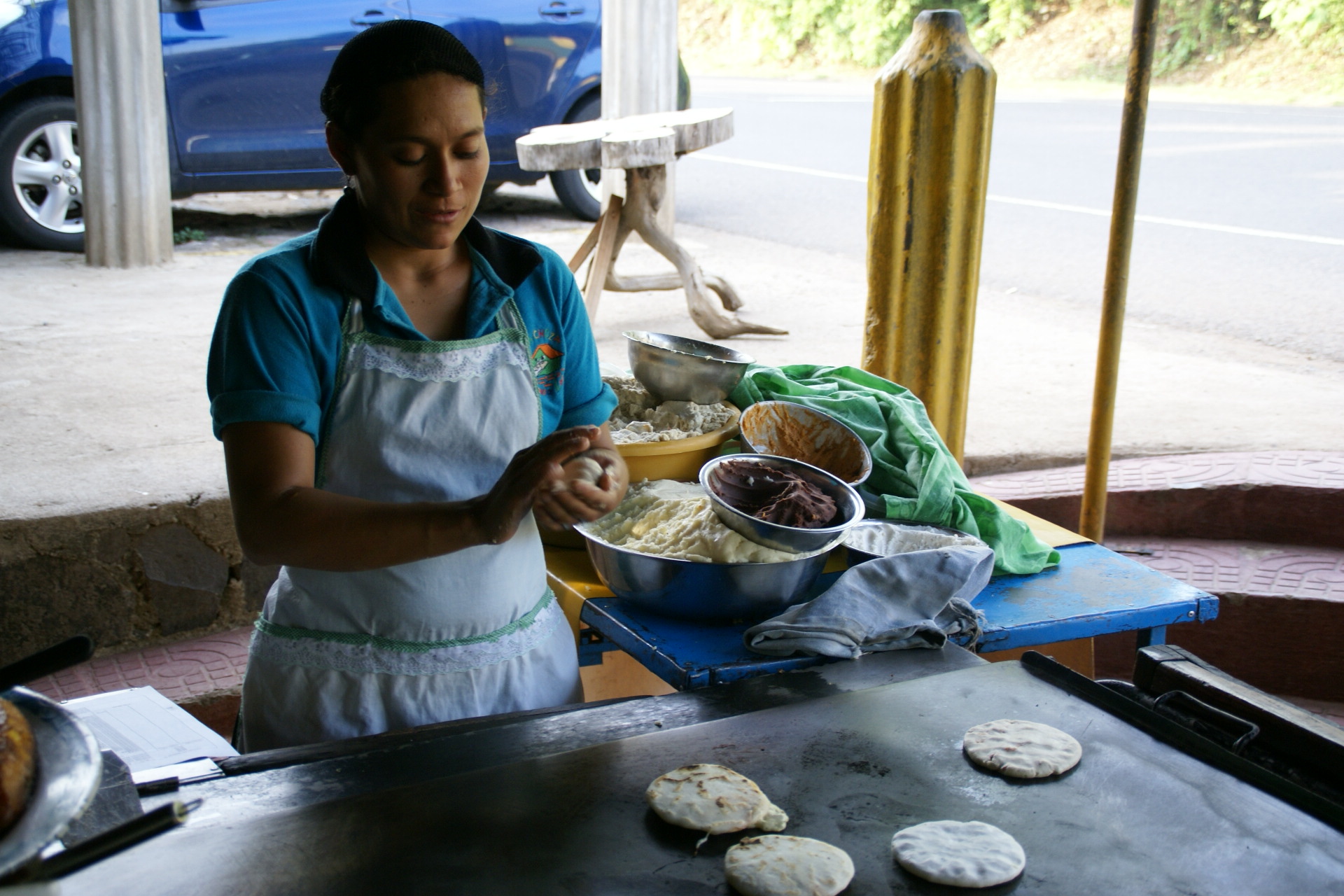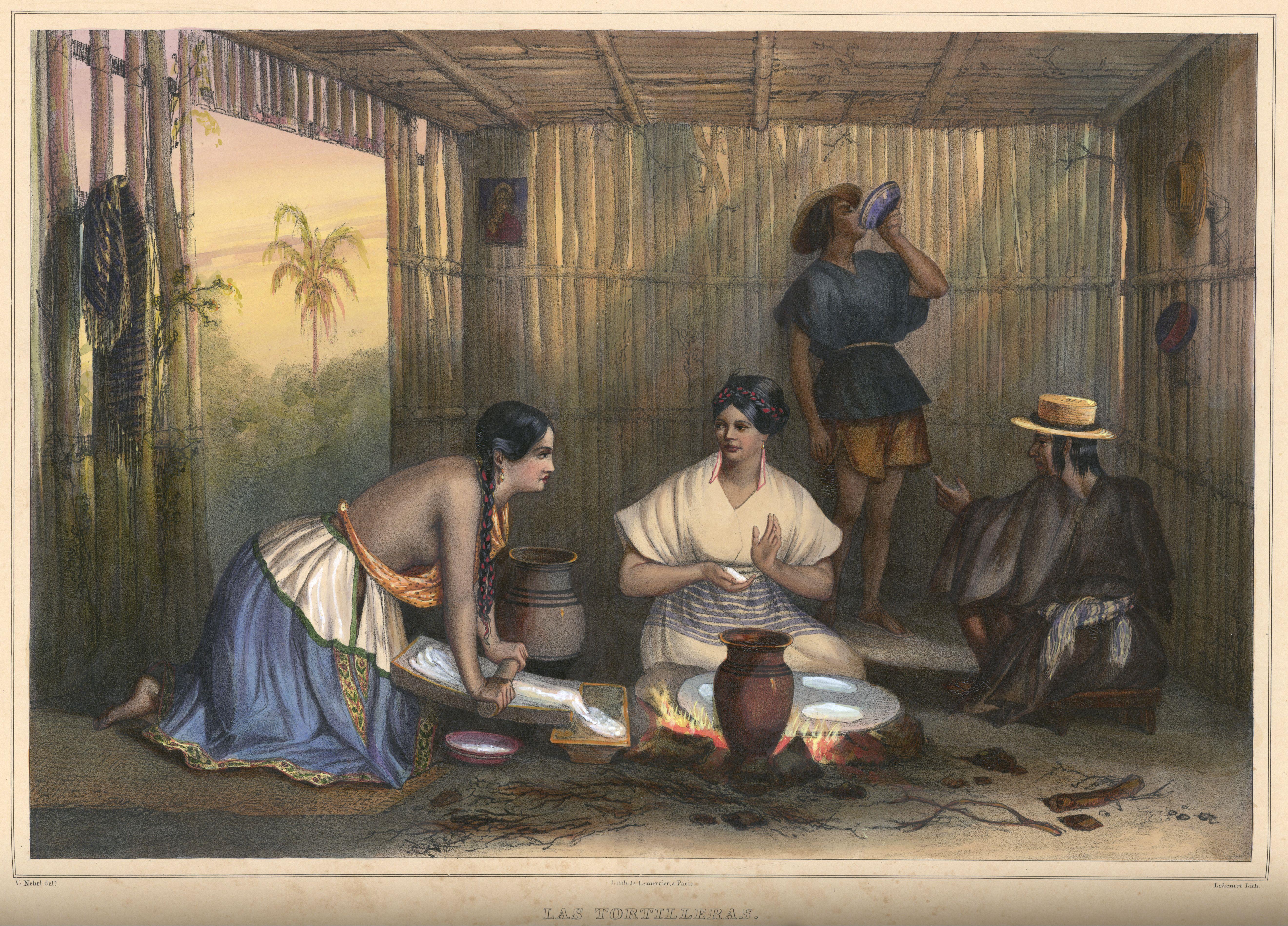|
Arepa
''Arepa'' () is a type of food made of ground maize dough stuffed with a filling, eaten in the northern region of South America since pre-Columbian times, and notable primarily in the cuisine of Colombia and Venezuela, but also present in the cuisines of Bolivia, Panama and other countries. It is commonly eaten in those countries and can be served with accompaniments such as cheese, '' cuajada'' (fresh cheese), various meats, chicken, avocado, or ''diablito'' (deviled ham spread). It can also be split to make sandwiches. Sizes, maize types, and added ingredients vary its preparation. It is similar to the Mexican '' gordita,'' the Salvadoran '' pupusa'', the Ecuadorian ''tortilla de maíz'' and the Panamanian ''tortilla'' or ''changa''. Origins The ''arepa'' is a pre-Columbian dish from the area that is now Colombia, Panama and Venezuela. Instruments used to make flour for the ''arepas'', and the clay slabs on which they were cooked, were often found at archaeological sites in th ... [...More Info...] [...Related Items...] OR: [Wikipedia] [Google] [Baidu] |
Colombian Cuisine
Colombian cuisine is a compound of the culinary traditions of the six main regions within Colombia (Pacific, Amazonian, Andean, Orinoco, Caribbean, and Insular). Colombian cuisine varies regionally and is particularly influenced by Indigenous Colombian, Spanish, and African cuisines, with slight Arab influence in some regions. Furthermore, being one of the most biodiverse countries in the world, Colombia has one of the widest variety of available ingredients depending on the region. History of Colombian food Colombian food is a unique blend of indigenous and European traditions with a strong Afro-Caribbean influence. The two largest indigenous groups prior to European conquest were the Tairona, who lived along the Caribbean coast, and the Muisca, who lived in the highlands to the South. Arepas, made from ground corn, are one of the oldest cooked dishes in Colombian cuisine. It is believed that the name derives from the word for corn in the Chibcha languages. Arepas are a popu ... [...More Info...] [...Related Items...] OR: [Wikipedia] [Google] [Baidu] |
Harina PAN
The Harina P.A.N. (abbreviation for Producto Alimenticio Nacional. English: ''National Food Product''), is the first brand of boiled maize flour in Venezuela. The brand itself became a synecdoche, as even with other large competitors in the market, it is used as a noun to indicate any similar maize flour. Usage Harina PAN is used to make the maize flour dough also known as "masa de arepa" or "masarepa", which is used to make Venezuelan dishes such as arepas, hallacas, empanadas, bollos pelones, and several Colombian dishes. Harina PAN is commonly found in varieties made from white and yellow corn. It contains no additives or gluten and is considered suitable for those with restricted diets. History The traditional preparation of arepa flour is very labor-intensive, requiring soaking, dehusking, and drying maize before pounding it in a large mortar. Precooked arepa flour was invented in the 1950s by Dr. Luis Caballero Mejías, a Venezuelan engineer who used the profits from ... [...More Info...] [...Related Items...] OR: [Wikipedia] [Google] [Baidu] |
Cornmeal
Cornmeal is a meal (coarse flour) or a cell membrane ground from dried corn. It is a common staple food, and is ground to coarse, medium, and fine consistencies, but not as fine as wheat flour can be.Herbst, Sharon, ''Food Lover's Companion'', Third Edition, Pg. 165, Barrons Educational Series Inc, 2001 In Mexico, very finely ground cornmeal is referred to as corn flour. When fine cornmeal is made from maize that has been soaked in an alkaline solution, e.g., limewater (a process known as nixtamalization), it is called masa harina (or masa flour), which is used for making arepas, tamales and tortillas. Boiled cornmeal is called polenta in Italy and is also a traditional dish and bread substitute in Romania. Types There are various types of cornmeal: *''Blue cornmeal'' is light blue or violet in color. It is ground from whole blue corn and has a sweet flavor. The cornmeal consists of dried corn kernels that have been ground into a fine or medium texture. *''Steel-ground ... [...More Info...] [...Related Items...] OR: [Wikipedia] [Google] [Baidu] |
Venezuelan Cuisine
Venezuelan cuisine is influenced by its EuropeanKohnstamm, Thomas; Kohn, Beth"Venezuela."Lonely Planet. Accessed October 2011. (Italian, Spanish, Portuguese, and French), West African, and indigenous traditions. Venezuelan cuisine varies greatly from one region to another. Food staples include corn, rice, plantains, yams, beans and several meats. Potatoes, tomatoes, onions, eggplants, squashes, spinach and zucchini are also common side dishes in the Venezuelan diet. Ají dulce and papelón are found in most recipes. Worcestershire sauce is also used frequently in stews. Venezuela is also known for having a large variety of white cheese ( queso blanco), usually named by geographical region. Main dishes Typical snacks Beverages * Beer * ''Chicha'' * '' Cocada'' – Coconut milkshake, found mostly in coastal areas. * Mango juice * Passion fruit juice * ''Malta'' – Non-alcoholic carbonated malt. * '' Papelón con limón'' * '' Ponche crema'' – Served especially duri ... [...More Info...] [...Related Items...] OR: [Wikipedia] [Google] [Baidu] |
Maize Meal
Cornmeal is a meal (coarse flour) or a cell membrane ground from dried corn. It is a common staple food, and is ground to coarse, medium, and fine consistencies, but not as fine as wheat flour can be.Herbst, Sharon, ''Food Lover's Companion'', Third Edition, Pg. 165, Barrons Educational Series Inc, 2001 In Mexico, very finely ground cornmeal is referred to as corn flour. When fine cornmeal is made from maize that has been soaked in an alkaline solution, e.g., limewater (a process known as nixtamalization), it is called masa harina (or masa flour), which is used for making arepas, tamales and tortillas. Boiled cornmeal is called polenta in Italy and is also a traditional dish and bread substitute in Romania. Types There are various types of cornmeal: *''Blue cornmeal'' is light blue or violet in color. It is ground from whole blue corn and has a sweet flavor. The cornmeal consists of dried corn kernels that have been ground into a fine or medium texture. *''Steel-ground yello ... [...More Info...] [...Related Items...] OR: [Wikipedia] [Google] [Baidu] |
Pupusa
A pupusa is a thick griddle cake or flatbread from El Salvador and Honduras, made with cornmeal or rice flour, similar to the Colombian and Venezuelan arepa. In El Salvador, it has been declared the national dish and has a specific day to celebrate it. It is usually stuffed with one or more ingredients, which may include cheese (such as ''quesillo'' or cheese with ''loroco'' buds), '' chicharrón'', squash, or refried beans. It is typically accompanied by ''curtido'' (a spicy fermented cabbage slaw) and tomato salsa, and is traditionally eaten by hand. Etymology There is no definite explanation for the origin of the word. The word for pupusa in one of El Salvador's native languages, Nawat, is . It is possible that the word stems from the verb ''pupusawa'' which means 'to puff up', but there is no known current or historical use of this word within the communities. Origin El Salvador and Honduras both claim to be the birthplace of the pupusa. Salvadoran archeologist Rob ... [...More Info...] [...Related Items...] OR: [Wikipedia] [Google] [Baidu] |
Gordita
A ''gordita'' () in Mexican cuisine is a dish made with masa and stuffed with cheese, meat, or other fillings. It is similar to the Colombian and Venezuelan arepa. ''Gordita'' means "chubby" in Spanish. There are two main variations of this dish, one of which is typically fried in a deep wok-shaped comal, consumed mostly in central and southern Mexico, and another one baked on a regular comal. The most common and representative variation of this dish is the ''"gordita de chicharrón"'', filled with chicharron (a spiced stew of pork rind) which is widely consumed throughout Mexico. Gorditas are often eaten as a lunch dish and accompanied by several types of sauce. Variations A gordita is typically prepared as a thick tortilla. The dough is most commonly made of nixtamalized corn flour, as also used for tortillas, but can also be of wheat flour, particularly in northern Mexico close to the U.S border. An old variant of corn gorditas uses ''masa quebrada'' (broken dough) where the ... [...More Info...] [...Related Items...] OR: [Wikipedia] [Google] [Baidu] |
Colombia
Colombia (, ; ), officially the Republic of Colombia, is a country in South America with insular regions in North America—near Nicaragua's Caribbean coast—as well as in the Pacific Ocean. The Colombian mainland is bordered by the Caribbean Sea to the north, Venezuela to the east and northeast, Brazil to the southeast, Ecuador and Peru to the south and southwest, the Pacific Ocean to the west, and Panama to the northwest. Colombia is divided into 32 departments and the Capital District of Bogotá, the country's largest city. It covers an area of 1,141,748 square kilometers (440,831 sq mi), and has a population of 52 million. Colombia's cultural heritage—including language, religion, cuisine, and art—reflects its history as a Spanish colony, fusing cultural elements brought by immigration from Europe and the Middle East, with those brought by enslaved Africans, as well as with those of the various Amerindian civilizations that predate colonization. S ... [...More Info...] [...Related Items...] OR: [Wikipedia] [Google] [Baidu] |
Venezuela
Venezuela (; ), officially the Bolivarian Republic of Venezuela ( es, link=no, República Bolivariana de Venezuela), is a country on the northern coast of South America, consisting of a continental landmass and many islands and islets in the Caribbean Sea. It has a territorial extension of , and its population was estimated at 29 million in 2022. The capital and largest urban agglomeration is the city of Caracas. The continental territory is bordered on the north by the Caribbean Sea and the Atlantic Ocean, on the west by Colombia, Brazil on the south, Trinidad and Tobago to the north-east and on the east by Guyana. The Venezuelan government maintains a claim against Guyana to Guayana Esequiba. Venezuela is a federal presidential republic consisting of 23 states, the Capital District and federal dependencies covering Venezuela's offshore islands. Venezuela is among the most urbanized countries in Latin America; the vast majority of Venezuelans live in the cities of th ... [...More Info...] [...Related Items...] OR: [Wikipedia] [Google] [Baidu] |
Hallaca
Hallaca (, ; alt. spelling, ''hayaca'' and ''ayaca'') is a traditional dish from Venezuela that looks like a tamal, though different in flavour, texture, ingredients and cultural significance. It consists of corn dough stuffed with a stew of beef, pork, or chicken and other ingredients such as raisins, capers, and olives, fresh onion rings, red and green bell pepper slices. There are vegetarian hallacas, made with black beans or tofu. Hallacas are folded in plantain leaves, tied with strings, and boiled. The dish is traditionally served during the Christmas season and has several regional variants. It has been described as a national dish of Venezuela. Some speculate it originated from the Orinoquia. Characteristic of the hallaca is the delicate corn dough made with consommé or broth, and lard colored with annatto. Hallacas are also commonly eaten in eastern Cuba, Trinidad where it is called pastelle, and parts of Colombia, Ecuador, Aruba, and Curaçao. Origins Hallaca is a ... [...More Info...] [...Related Items...] OR: [Wikipedia] [Google] [Baidu] |
Nixtamalization
Nixtamalization () is a process for the preparation of corn, or other grain, in which the grain is soaked and cooked in an alkaline solution, usually limewater (but sometimes aqueous alkali metal carbonates), washed, and then hulled. The term can also refer to the removal via an alkali process of the pericarp from other grains such as sorghum. Nixtamalized corn has several benefits over unprocessed grain: It is more easily ground, its nutritional value is increased, flavor and aroma are improved, and mycotoxins are reduced by up to 97%–100% (for aflatoxins). Lime and ash are highly alkaline: the alkalinity helps the dissolution of hemicellulose, the major glue-like component of the maize cell walls, and loosens the hulls from the kernels and softens the maize. Corn's hemicellulose-bound niacin is converted to free niacin (a form of vitamin B3), making it available for absorption into the body, thus helping to prevent pellagra. Some of the corn oil is broken down in ... [...More Info...] [...Related Items...] OR: [Wikipedia] [Google] [Baidu] |
South America
South America is a continent entirely in the Western Hemisphere and mostly in the Southern Hemisphere, with a relatively small portion in the Northern Hemisphere at the northern tip of the continent. It can also be described as the southern subregion of a single continent called America. South America is bordered on the west by the Pacific Ocean and on the north and east by the Atlantic Ocean; North America and the Caribbean Sea lie to the northwest. The continent generally includes twelve sovereign states: Argentina, Bolivia, Brazil, Chile, Colombia, Ecuador, Guyana, Paraguay, Peru, Suriname, Uruguay, and Venezuela; two dependent territories: the Falkland Islands and South Georgia and the South Sandwich Islands; and one internal territory: French Guiana. In addition, the ABC islands of the Kingdom of the Netherlands, Ascension Island (dependency of Saint Helena, Ascension and Tristan da Cunha, a British Overseas Territory), Bouvet Island ( dependency ... [...More Info...] [...Related Items...] OR: [Wikipedia] [Google] [Baidu] |






.jpg)

